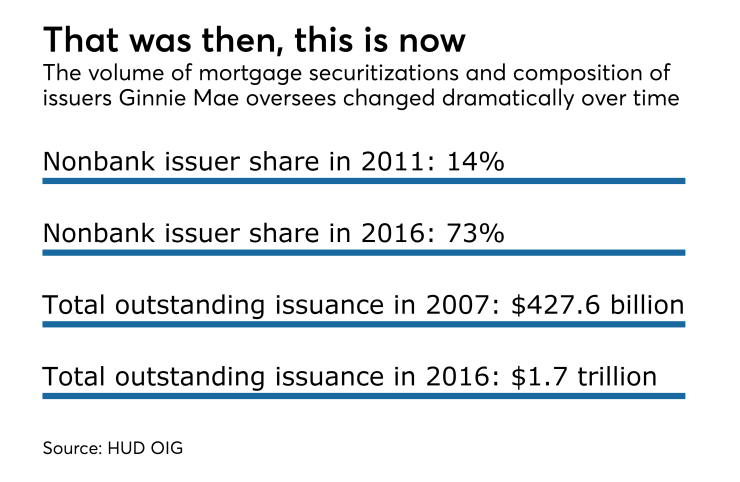Ginnie Mae pledged to vet issuers more thoroughly after a government watchdog criticized its exposure to risks posed by nonbanks.
A report by the Department of Housing and Urban Development's inspector general took Ginnie to task for inadequate management of the growing number of nonbanks among its issuers. But banks and nonbanks alike will be watched more closely, said Michael Bright, the acting president of Ginnie.
"We want more information from the issuers who are our counterparties," Bright said.
Nonbanks, unlike banks, tend to operate monoline mortgage business and rely more on third-party financing because they lack balance sheets and deposits, and could in some cases "see liquidity dry up faster than a diversified bank," Bright said.
But "banks can go under, too," he said.
"A balance sheet is not a panacea," he said, noting that diversified business lines are not necessarily a cure-all. The various financial services a bank offer could be, for example, concentrated in a region where there are economic concerns.
Bright's comments Tuesday followed soon after the head of the Mortgage Bankers Association — a trade association that represents many nonbanks — challenged the HUD IG’s conclusions.

The report "mischaracterized the role of, and the risks posed by, nonbank issuers," David Stevens, the association’s president, said in a written statement.
Though banks have historically been more heavily regulated, today nonbanks are closely supervised by the Consumer Financial Protection Bureau and others, Stevens argued.
Nonbanks are "subject to stronger state and federal regulation than ever before, including robust examinations by both the states and CFPB and better information sharing between regulators at all levels," Stevens said.
Mortgage companies outside the banking industry also filled in a gap at Ginnie when several bank issuers fled the market during the financial crisis, he said.
While those changes help contain nonbanks' risk, Ginnie could do a better job overseeing the unique liquidity concerns they face as the IG suggested, Bright said.
It has taken many steps to do this, but those efforts were "blunt instruments," and the risk needs to be targeted more precisely, Bright said.
Ginnie — which oversees government-insured mortgage securitization issuers — should determine the maximum default that it could handle for each issuer, as well as better manage nonbank counterparty risk, according to the IG report.
Otherwise Ginnie might be at risk of having to take a U.S. Treasury draw to stay afloat in the event a large-scale issuer default, Ronald Hosking, a regional inspector general, wrote in the Sept. 21 report he authored.
"Ginnie Mae was not prepared for the rapid growth and shift in issuer base, and its staff lacked the skills necessary to immediately respond to increased risks posed by these changes. As a result, Ginnie Mae may not identify problems with issuers in time to prevent default," the report said. "Additionally, it may not be able to properly service loans absorbed in a default and may require additional funds from the United States Treasury to pay investors in the event of a large issuer default."
The many steps Ginnie took to address risk as nonbanks grew from 14% of its guarantees of single-family securitizations in 2011 to 73% in 2016 were not "timely" or effective enough, according to the report. The principal balance of outstanding issuance Ginnie has to oversee also has grown considerably, from $427.6 billion in 2007 to $1.7 trillion in 2016.
"In an internal memorandum, dated March 2017, Ginnie Mae stated that it would be difficult to absorb portfolios greater than 100,000 loans or with high levels of delinquency without impacting servicing standards," the report said.
Ginnie's initial written response to the report acknowledged the risk, but also said that the government agency "is not wholly without the ability to manage such a situation," said Michael Drayne, senior vice president in Ginnie's Office of Issuer and Portfolio Management.
"The report implies a deficiency on the part of Ginnie Mae that nondepository issuers have grown to the scale they have," Drayne said. "But that this has occurred is a function of the housing finance system's adaptation to a variety of factors and policy actions."
Ginnie is "absolutely aware that we have seen a massive evolution in our issuer base [and] we've seen massive growth in our securities," Bright said. "We are not blind to any of these dynamics. We will be taking additional steps."
In the past Ginnie has blamed, and
If Ginnie got more independence, money and staff as it has requested in the past, Bright would ensure it made "good use of taxpayer funds;" but he added: "That said, I'm not asking for more money. We have a job to do. We're going to do our job."





